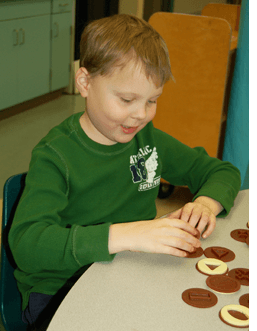
But we are also leveraging 21st century technologies to transform lives. I’d like to introduce you to Austin Porter. Austin is a 2nd-grader in the Structured Communication Classroom at Hough Elementary.
Austin developed normally until he reached eighteen months. At two, the handful of words he possessed disappeared. Austin’s mom noticed huge changes in his behavior and affect. With the help of medical professionals, Austin was diagnosed with severe autism. One of the most difficult challenges of autism is the child’s inability to communicate effectively. For children with profound autism, communication can be guesswork. Basic needs are easier to identify—for example when the child wants to eat or drink. But it becomes more difficult when the child is upset and cannot tell you why.
Two years ago, in partnership with the school, Austin’s mother began using Applied Behavior Analysis (ABA) therapy at home. At the time, Austin would quite often tantrum when he could not communicate his wants and needs. He also was prone to engage in self-injurious behavior. By functionally assessing the relationship between a targeted behavior and the environment, the methods of ABA can be used to change that behavior.
Simultaneously, school staff and the family began to use a Picture Exchange Communication System (PECS) as a communication tool for Austin. PECS is designed to teach functional communication. It has been and continues to be implemented in a variety of settings so users have the skills to communicate their wants and needs. PECS does not require complex or expensive materials since it uses picture symbols as the modality. Austin used Velcro picture boards at home and at school to navigate his day. Very often at school Austin was not aware of others. If he interacted with anyone it was frequently in a negative and aggressive way.
This year, Austin was given an iPad loaded with Proloquo2go—a full-featured communication app for people who have difficulty speaking. With natural sounding text-to-speech voices, nearly 8000 up-to-date symbols, powerful automatic conjugations, and a large vocabulary, it gives voice to the user. For Austin, this new communication resource has been transformative.
For example, this fall Austin was able to communicate to others that he had severe headaches, likely caused by allergies. No one knew how bad his headaches were, because there were no outward symptoms. But now Austin has the ability to speak. Subsequently, he’s being treated more effectively for his allergies, which is reducing the frequency of headaches.
He’s a happier and healthier kid. Who wouldn’t be? Communicating is a basic human need. Giving Austin a voice also has helped him in social settings. He attempts to interact appropriately with other kids and has not been aggressive toward anyone this year. And, Austin has proven to be quite good at helping younger children. In fact, you can even say, he demonstrates patience with them. Using the iPad also has brought out his sense of humor. He will give a wrong answer, sometimes intentionally, and then laugh about it—a playful and joyful expression of self-will!
I want to close this e-News with this last vignette. It illustrates so simply the power of these 21st century technologies to transform lives. This fall, Austin came to his teacher and used his iPad to say, “I want a rice cracker.” She responded, “We are working right now, snack is in a little while.” He started flipping through his iPad and found the phrase, “Please, they are so yummy!” How could anyone refuse?
It may be just a rice cracker for you and me, but for Austin, these tools have opened new horizons. They have empowered him with voice—to communicate his wants, his needs, and his feelings. He’s building more productive and positive relationships with his peers, his teachers, and his family. Remarkable outcomes!
In Vancouver schools, we’re changing lives, one iPad at a time.
Thanks again for all that you do.
Take care,

